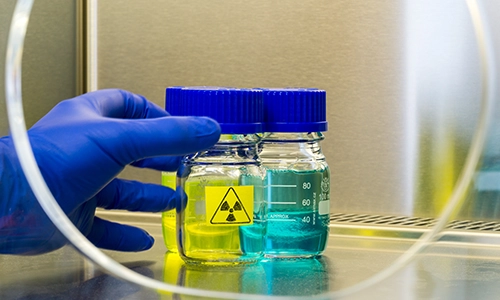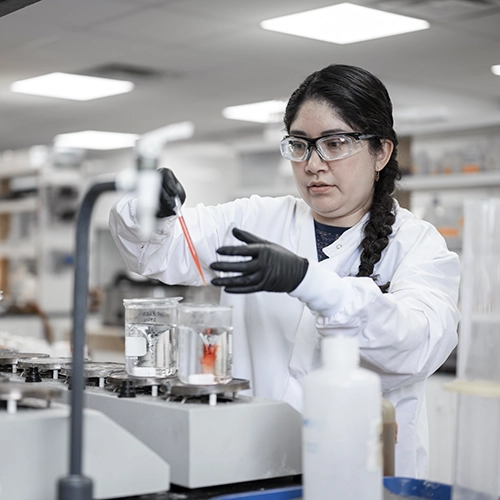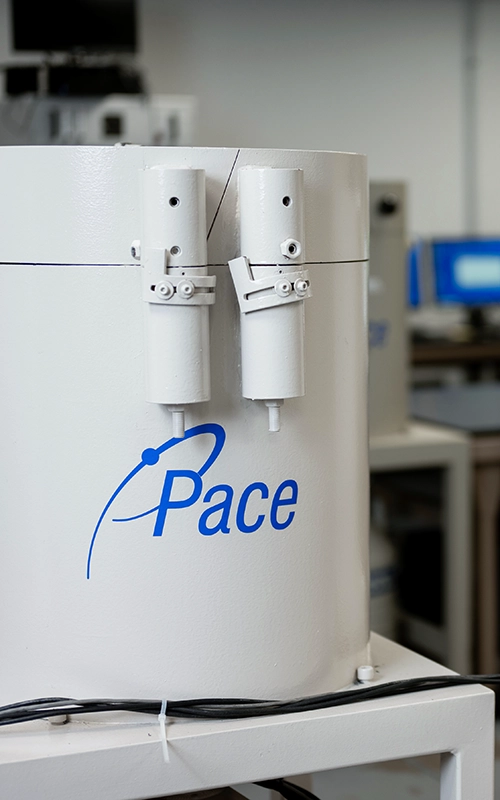Experienced Radiochemistry Analysis You Can Trust
When it comes to radiochemical analysis, experience matters. Pace® offers one of the most comprehensive environmental radiochemistry testing programs in the United States. Our professionals are experienced in their discipline and dedicated to supporting our clients’ needs for timely, high-quality environmental information. Pace® radiochemistry testing lab credentials include:
- NRC Materials Handling License
- DOECAP, DOD ELAP, ISO 17025, and NELAP Accredited
- 45+ State Certifications
- Utah DOH Certified #ANTE2
- Westinghouse, Qualified Supplier – 10 CFR Part 50 App. B;
- NQA – 1
- USDA License for quarantined soil
- Participant – Department of Energy, Mixed Analyte Performance Evaluation Program, Lab Code WEST04 and OTLI01
Where Does Radioactivity Come From?
Naturally Occurring Radioactive Material (NORM)
Naturally occurring radioactivity has been present since Earth’s creation and can be found in air, water and throughout the planet’s crust. Examples of NORM include long-lived radioactive elements, such as uranium, thorium, and potassium, as well as any of their decay products, including radium and radon. Anthropogenic, or synthetic radioactivity, can also originate from nuclear reactors, the fallout from nuclear weapons testing, nuclear accelerators, and the manufacture of isotopes used for medical purposes. Cosmogenic radioactivity is created when cosmic rays strike the earth, inducing radioactivity in the atmosphere.
Technologically Enhanced Naturally Occurring Radioactive Material (TENORM)
When NORM is disturbed or altered from natural settings or present in a technologically enhanced state due to past or present human activities and practices, the material is known as Technologically Enhanced Naturally Occurring Radioactive Material (TENORM). “Technologically enhanced” refers to a relative increase in radionuclide concentrations above background radiation levels due to changes to the radiological, physical, and chemical properties of the radioactive material.
Naturally Occurring And Accelerator-produced Radioactive Materials (NARM)
Naturally occurring and accelerator-produced radioactive materials (NARM) are primarily radium-contaminated waste, including medical and industrial radium sources, soils with natural radium, and deposits made by oil and gas inside refinery pipes and well casings.

Why Test For Radioactivity?
Radioactivity is dangerous to humans and the environment because of its ability to interact with and change matter. Radiation is “ionizing,” meaning it has enough energy to remove electrons from atoms or molecules when it passes through or collides with some material.
How Do We Test For Radioactivity?
Radioactivity is measured by detecting atomic disintegrations in a sample and counting the number of events that occur during a specific period. Scientific instruments employ one of five basic technologies: High-Purity Germanium Crystal Detection, Liquid Scintillation Counting, Alpha Scintillation Counting, Alpha Spectroscopy, or Gas Flow Proportional Counting. Prior to detection, specific isotopes are often isolated from the sample matrix through chemical separation.


What Is The Common Reporting Convention For Radiochemistry?
Radioactivity measurements involve counting the characteristic atomic disintegrations of an isotope followed by complex statistical calculations. Each measurement has a minimum detectable concentration (MDC), also known as minimum detectable activity or MDA, which varies based on sample amount and elapsed time. Therefore, each sample result consists of three values: the calculated activity, the total propagated uncertainty (TPU), and the MDC, reported as Activity, +/- TPU, MDC. For example, Radium-228 = 6.2 +/- 1.8, 0.95 pCi/L (picocuries per liter).
Unlike environmental chemistry, radiochemistry measurements are not limited by Method Detection Limits (MDLs). Lower MDCs and uncertainties may be obtained through increased sample volumes or count times. Based on experience, the laboratory targets standard MDCs that are below most common regulatory requirements.
Pace® Radiochemistry Testing Services
Pace® supports a wide array of projects for many different industries. Here are just a few of the types of services we offer.
- Drinking Water
- State private well testing
- DOE
- DOD
- NRC site decommissioning
- Coal combustible residuals
- Radiation safety program support
- Sediment dating
- Land-applied sludge
- EU import/export requirements
- Human bioassay
- Oil and Gas
- Mining
- NORM/TENORM
- Dental Implants

Radionuclide Test Methods
The only radiation detection technology that provides sufficient information to accurately and reliably identify radionuclides from their passive gamma ray emissions.
The measurement of the radioactive activity of a sample material which uses the technique of mixing the active material with a liquid scintillator (Ultima Gold) and counting the resultant photon emissions. This analysis is generally used to evaluate radionuclides that emit lower energy betas.
This method is used to evaluate radionuclides that emit higher energy beta radiation. The proportional counter is a type of gaseous ionization detector device used to measure particles of ionizing radiation.
This method is used to evaluate radionuclides that emit gamma radiation. These elements are typically seen around nuclear power operations.
How Are Radionuclides Regulated?
The principal federal agencies with responsibilities for radiation protection of the public are the United States Environmental Protection Agency (EPA), the Nuclear Regulatory Commission (NRC), and the Department of Energy (DOE). Of these, only EPA and DOE may develop guidance or regulations for TENORM.

The Indoor Radon Abatement Act set a long-term goal of making indoor air as radon-free as the ambient, outside air. Currently, no federal, enforceable regulations control indoor radon levels—only guidelines with recommendations and a national goal of indoor radon air concentrations less than or 4 pCi/L.
Additional Resources
Pace® maintains an extensive list of accreditations and certifications to meet environmental compliance and program requirements at the national and state level.